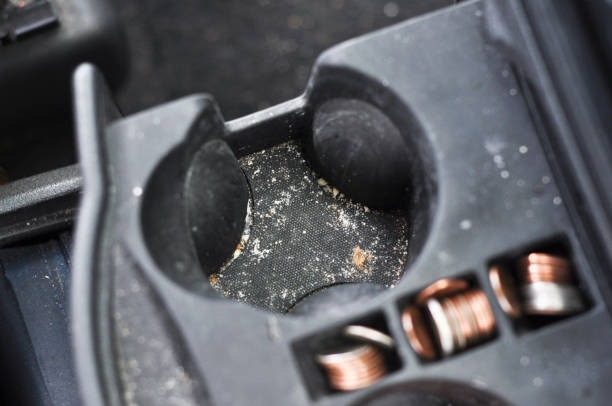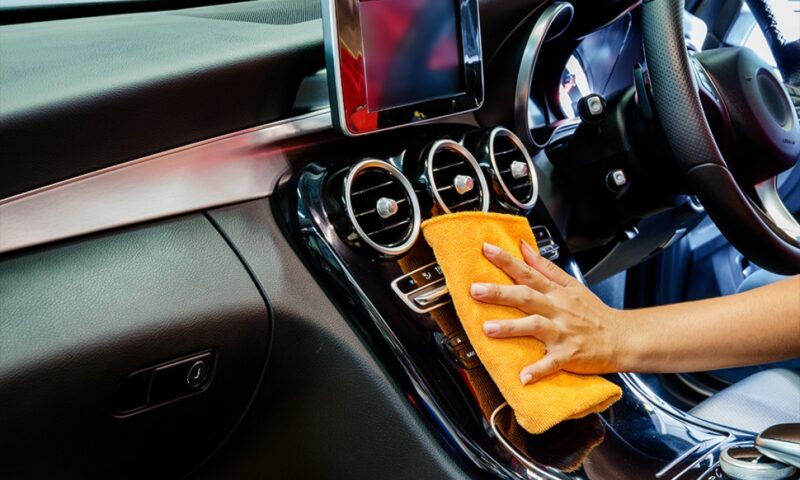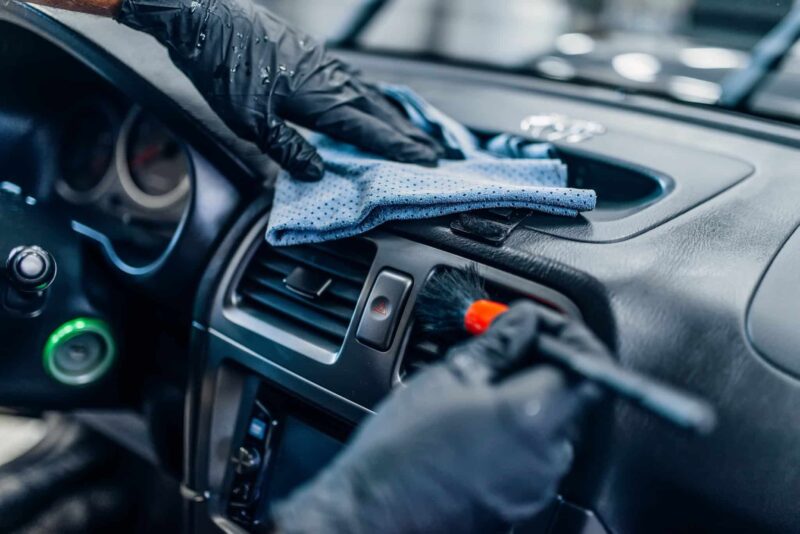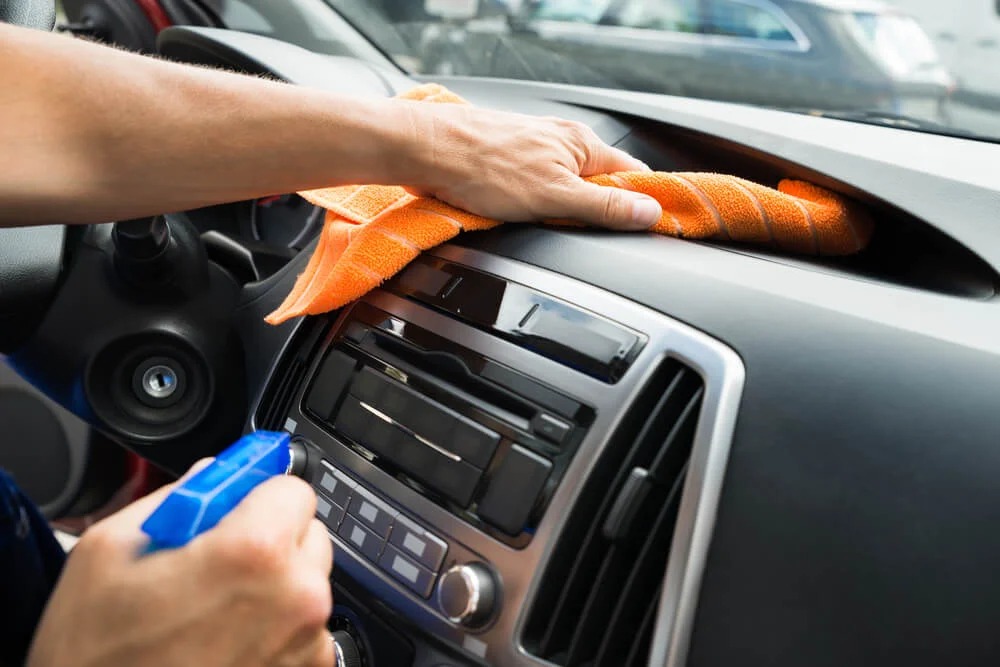If you’re like most drivers, your car’s interior sees everything from fast food wrappers to coffee spills to muddy shoes.
But when was the last time you gave it a proper, deep clean? Not just a quick wipe of the dashboard or shaking out the floor mats, but a thorough interior cleaning?
It’s easy to overlook because the mess builds up gradually. One day it smells like a pine air freshener, the next like something from a gym locker.
But beyond hygiene and aesthetics, regular interior cleaning actually affects your health, your car’s resale value, and even your driving experience.
The Real Cost of a Dirty Car Interior

Let’s talk about what’s hiding in plain sight. The average steering wheel harbors four times more bacteria than a public toilet seat.
That’s not a scare tactic – it’s a reality if you’re not cleaning regularly. And carpets? They’re a trap for allergens, mold spores, and dust mites.
That stale smell you’ve “gotten used to”? That’s bacteria and mildew setting up shop.
A messy car interior also wears down faster. Dirt acts like sandpaper on surfaces. Think of the fine grit on your leather seats or crumbs grinding into the seams of your upholstery.
Over time, this leads to fading, cracking, and that worn-out look you see in older cars that were never properly maintained.
How Often Is “Regular”? (It’s Not Just Once a Year)
There’s no one-size-fits-all answer, but here’s a general rule:
- Light-use drivers (solo commuters, no pets/kids): Every 1-2 months
- Daily drivers with passengers or kids: At least once a month
- Pet owners or rideshare drivers: Every 2-3 weeks, or even weekly
- Allergy sufferers: Every 2 weeks, minimum
If you eat in your car or carry gear that leaves behind dirt or debris, you may want to clean more often.
Your routine should match how you actually use your car – not just how you think it should be used.
Where Most People Fall Short

Here’s what many car owners do: vacuum the seats and floors, wipe down the dashboard with whatever’s in the glovebox, and call it a day. But there’s more to keeping your interior healthy and looking fresh.
- Neglected areas: Cup holders, vents, seat crevices, under the seats, and door pockets often get skipped – yet they’re hotspots for germs and grime.
- Overusing harsh cleaners: Many off-the-shelf sprays damage surfaces or leave behind residue.
- Forgetting upholstery: Fabric seats need to be shampooed every few months. Leather needs conditioning or it will crack.
- Skipping the air vents: That musty smell on startup? Probably bacteria and mold in the HVAC system.
This is where professional car detailing services come in handy – especially if you want a reset. Grandeur Autos goes beyond surface cleaning.
They handle those hard-to-reach areas, apply the right products for each material, and even deodorize your ventilation system.
It’s not just for show cars – it’s for anyone who values cleanliness, comfort, and long-term care.
Interior Detailing vs. DIY Cleaning
You might wonder if professional interior detailing is worth the investment when you could just clean it yourself.
The short answer? Yes – if you want the kind of deep clean that actually removes stains, neutralizes odors, and preserves your car’s interior materials.
Here’s the key difference:
| Aspect | DIY Cleaning | Professional Detailing |
| Time Required | 1–2 hours (minimum) | 2–4 hours (you don’t lift a finger) |
| Equipment | Household vacuums, wipes | Commercial-grade extractors, steamers |
| Effectiveness | Surface level | Deep, material-specific cleaning |
| Long-Term Impact | May damage interior with wrong products | Preserves leather, fabric, plastics |
Even one professional deep clean every few months can make your regular maintenance much easier.
The Silent Culprit: Air Quality in Your Cabin

Did you know your cabin air filter isn’t just for dust – it also helps trap mold spores and pollutants from entering the car’s interior?
A dirty interior actually worsens your in-car air quality, especially when vents are clogged or mold begins to grow in carpets or upholstery.
This is especially problematic for people with asthma, allergies, or young kids. Regular interior cleaning helps reduce exposure to:
- Dust mites
- Pet dander
- Mold and mildew
- Volatile organic compounds (VOCs)
If your car smells off, gives you watery eyes, or you sneeze often inside it, that’s your body telling you it’s time for a reset.
Seasonal Triggers: When to Ramp Up Your Routine
Different seasons bring different interior hazards:
- Winter: Salt and slush get tracked in and ruin carpets
- Spring: Pollen builds up fast, especially on vents
- Summer: Food crumbs spoil faster; heat amplifies odors
- Fall: Leaves and moisture create the perfect mold environment
Use seasonal changes as a reminder to do a full interior reset. Ideally, detail your car at least four times a year – once per season – if you want to stay ahead of grime and allergens.
Signs Your Interior Needs Immediate Attention
Some clues are obvious. Others creep up until the mess is undeniable. Watch for these signs:
- Persistent odors even after airing out the car
- Sticky or greasy dashboard and controls
- Visible dust buildup on vents or instrument panels
- Foggy windows (could indicate mold or excess moisture)
- Pet hair that won’t vacuum up easily
- Food smells that linger long after eating
When your car crosses from “a little dusty” to “I’m embarrassed to offer rides,” it’s past due.
Final Thoughts: Make It a Habit, Not a Chore

You wouldn’t wait a year to clean your kitchen, so why do the same with your car? It’s the space where you spend hours of your life – commuting, road-tripping, or just running errands.
A clean interior makes driving more pleasant, keeps your car smelling nice, and shows pride in what you own.
More importantly, regular interior cleaning protects your investment. Whether you’re keeping the car long-term or planning to sell, a spotless interior speaks volumes.
And if you don’t have time to deep clean it yourself? That’s what professional car detailing is for. Every car deserves to feel new – even if it’s not.
Frequently Asked Questions
How can I keep my car’s interior cleaner if I have kids?
Use washable seat protectors, keep snacks in sealed containers, and stash baby wipes in the glovebox. A small car organizer with toys or essentials can help prevent clutter.
What materials need different care (leather vs. fabric)?
Leather needs conditioning every 2–3 months to prevent cracking, while fabric benefits from occasional shampooing to prevent odors and stains. Always use material-specific cleaners.
Are DIY ozone machines safe for removing car odors?
Ozone machines can be effective at neutralizing odors, but they must be used with caution and proper ventilation. Never stay in the car during ozone treatment.
What’s the best way to remove pet hair from upholstery?
Use a rubber glove or a pet hair removal brush to lift hair from seats and carpets. Vacuum afterward to collect loose fur.
How do I prevent mildew in my car during wet seasons?
Use moisture absorbers or desiccant packs, especially in footwells. Clean up wet spots quickly, and make sure weather seals on doors are intact to prevent leaks.

